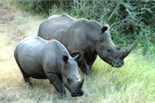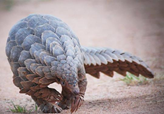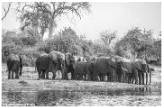-
Elephants losing tusks
People killing elephants for their tusks has long been a problem worldwide. Although laws have been introduced to ban the selling of tusks, they have not been enough to save the elephants.
But the giant animals have now “developed” their own solution to stay safe from hunters----by not growing tusks at all.
Scientists found that among female African elephants, as many as 98 percent of them now have no tusks, reported The Independent newspaper. The number was 15 percent in 1998 and only 1 percent in 1930, according to the BBC.
But this solution has less been developed by elephants themselves, and more by evolution.
Evolution is all about natural selection(选择). When an environment changes, for example, animals and plants that can deal with the change will stay alive while others won’t. And for elephants, the change came when hunters started killing them for their tusks. As a result, elephants with big tusks couldn’t stay alive because hunters wanted to shoot them. Those born with tusks managed to stay alive and give their “tuskless” genes(基因)to their babies. As a result, more and more elephants are now being born without tusks.
But this solution, as effective(有效地)as it might be, is a high price to pay for elephants. Tusks are important and play a number of roles, especially for male elephants, including fighting with other males, lifting and digging things up.
This is why scientists hope there can be other ways to protect elephants against hunters. They believe that when they are less likely to be killed , elephants will be able to grow tusks again.
To David Cowdrey, head of Policy and Campaigns at the International Found for Animal Welfare UK, however, this is not very likely to happen in the near future.
“Unfortunately, it comes down to the markets,” he told The Guardian. “As long as people will pay high prices for products that come from endangered animal and plants, they’re going to have price on them and that causes the hunting.”
1.Which of the following is TRUE according to the passage?
A. Elephants learned to lift and dig things up without tusks.
B. Elephants chose not to grow tusks because of their dangerous environment.
C. Elephants with no tusks had a greater chance of passing down their genes.
D. A tuskless elephant gives birth to more baby elephants than an elephant with big tusks.
2.The underlined word “evolution” in paragraph 4 means “_________” ?
A. gradual change B. sudden development C. complete loss D. rapid growth
3.What can you learn from the last two paragraphs?
A. We should work out a better solution to protect elephants.
B. People should pay lower prices for products made with elephant tusks.
C. Elephants’ living environments will soon be improved.
D. The key to elephant protection is stopping the trade in tusk products.
九年级英语阅读单选困难题查看答案及解析
-

In 2013 alone at least 20,000 African elephants were killed for their teeth. In South Africa over the last two years more than 2,200 rhinos were killed for their horns. These numbers are alarming, because current rates of illegal hunting are faster than birth rates, which could lead to extinction for these ecologically important creatures in their environment. Indeed, some elephant and rhino populations are on track to be locally extinct within the next decade.
If you are reading this, you may already be aware of these facts. But you might not know that wildlife trafficking (走私) not only threatens the existence of elephants and rhinos but is also leading to extinction of other species, such as tigers, tortoises, sea turtles — and the world’s most trafficked mammal(哺乳动物) — pangolins.

Pangolins are the only mammals that are entirely covered in tough scales(鳞), which makes them look very strong. But actually they are endangered mammals. There are eight different kinds of pangolins, four in Asia and four in Africa, and all are threatened with extinction. Although pangolins are protected throughout most of the countries where they live, high demand in East Asia, where the delicious pangolin meat is considered a delicacy and where their scales are used in traditional medicines, is driving an illegal trade in both live animals and pangolin parts. The number of pangolin trafficking is shocking. Experts believe that over the last 10 years more than 1 million pangolins were taken from the wild. It is estimated that between 40,000 and 81,250 pangolins were killed for the illegal trade in 2013 alone.
In February, the United States released a plan to deal with wildlife trafficking, which lays out the steps we will take to fight the illegal trade in wildlife, including pangolins. We are strengthening the carrying out of the plan, building international cooperation and contribution to protect wildlife, raising awareness to drive down the demand that is fuelling the illegal trade.
Get involved and remember World Wildlife Day (March 3) by spreading the plan. Use social media and tell everyone that now is the time to get serious about wildlife crime and end the demand that threatens species, big and small, from the huge elephant to the shy pangolin.
1.How many rhinos were killed in South Africa during the last two years?
A. More than 81,250. B. More than 20,000.
C. More than 2,200. D. More than 40,000.
2.How many kinds of pangolins are there in Asia?
A. Ten. B. Four. C. Six. D. Eight.
3.What does the phrase ‘carrying out’ mean in the fourth paragraph?
A. Putting the plan into effect. B. Moving the plan to a place.
C. Making a new plan. D. Taking the plan with you.
4.What does the writer want us to know after reading the passage?
A. Protecting wild animals is our duty.
B. Something about World Wildlife Day.
C. Something about illegal trade in East Asia.
D. Wild animals are in danger and we must get involved.
九年级英语阅读单选中等难度题查看答案及解析
-
Wildlife Lessons
The elephants stood face to face. Their big ears fanned out. A group of school kids looked at the elephants from a_______ . They came from a village just outside Makgadikgadi Pans National Park, in Botswana, Africa. “Are the elephants fighting? Someone asked.
“No, it’s a_______,”another child said. “ They’re playing.”
Kolobetso, 13, was a bit nervous. “She’d grown up with a fear that elephants are _______.” Walona Sehularo told reporters. He was also in the truck. He works with Elephants for Africa(EFA).The group is trying to_______ elephants and help people live peacefully alongside them.
In parts of rural(农村)Africa, elephants_______ freely . They often connect with people. Many people fear them, and they regard them as animals that can cause_______. Fight between people and elephants is_______.EFA wants to change that. It hopes to encourage young people to become protection leaders. Threatened(威胁)by poaching(偷猎)in other parts of Africa, _______ have log found safety in Botswana. The country has about 130,000 elephants. That is more than any other country in Africa. Many can be_______along the Boteti River.
But elephants also hang out onto farms. Botswana’s elephants attract(吸引)tourists to Makgakdikgadi Pans.________few local children can afford to visit. By leading them on trips there, EFA wants to teach kids to love the park and its wildlife so that kids might be ________working as park officers, guides, or researchers in the future.
When Kolobetso and her classmates toured the________ , an elephant headed straight for the truck, protecting its group. Then it walked away. The kids were________ .” It was one of those moments you cannot explain,” Schularo says. “It ________ you with a great joy.”
Researchers say the threat of poaching in surrounding(周围的)countries has driven________elephants to Botswana. Much of the land is protected. For now, the country may be the safest place on Earth for elephants.
1.A.car B.bus C.truck D.train
2.A.game B.subject C.fight D.work
3.A.friendly B.comfortable C.dangerous D.careful
4.A.protect B.compare C.control D.change
5.A.turn out B.hang out C.make up D.take in
6.A.peace B.surprise C.trouble D.disease
7.A.common B.excellent C.famous D.important
8.A.lions B.tigers C.monkeys D.elephants
9.A.helped B.killed C.forgotten D.found
10.A.And B.But C.So D.Or
11.A.worried about B.interested in C.surprised at D.tired at
12.A.country B.city C.zoo D.park
13.A.amazed B.bored C.tired D.stressed
14.A.helps B.compares C.fills D.covers
15.A.little B.less C.fewer D.more
九年级英语完型填空中等难度题查看答案及解析
-
—I learned about elephants the day before yesterday. There are no bones(骨头) in the back of their feet.
—________.
A. That's amazing B. Bad luck C. Good idea D. No problem
九年级英语单选题中等难度题查看答案及解析
-
①Elephants are the biggest land animals alive today. We have worked with elephants for a long time, but there are still many misunderstandings about elephants.
②Some people think that elephants will run away if they see a mouse. This is untrue, in fact, elephants have such poor eyesight that they would not usually see a mouse, even if one came very near them.
③ “Elephants never forget.” is another fallacy(谬论). No evidence suggests that elephants have better memories than any other animals.
④Finally, there is the myth(神话) that when the time comes for an elephant to die, it goes to some kind of elephant graveyard(墓地), but no one has ever found such a graveyard. What elephants probably do when they are old and sick is finding a cave and staying in it, so they will be safe until they either get better or die.
⑤In Thailand, when the country was still called Siam, if someone found a white elephant, they gave it to the king because it was rare. The king had no choice but to keep the animal and feed it, even though it had no use for him. From this practice we get the expression, “a white elephant”, which means something that is not useful to us.
1.Elephants are not afraid of mice because mice______________.
A.are afraid of elephants B.never attack elephants
C.are too small for elephants to see D.never go into caves
2.According to the passage, which of the following sentence is right?
A.Elephants are the biggest animals alive today.
B.An elephant’s memory is the worst.
C.In Thailand, if someone found a white elephant, they must look after it themselves.
D.In Siam, if someone found a white elephant, it was given to the king.
3.The passage is about______________.
A.white elephants B.myths of elephants
C.how elephants hurt people D.the history of elephants
4.If we put the passage into three parts, which of the following is the best?
(Para(自然段)1=①, Para. 2=②, Para. 3=③, Para. 4=④, Para 5=⑤)
A.①②,③④,⑤ B.①;②③;④⑤
C.①;②③④;⑤ D.①②;③;④⑤
九年级英语阅读单选困难题查看答案及解析
-
Usually the elephants ________ something to eat in return for doing things for people.
A.offer B.are offered C.were offered
九年级英语单选题中等难度题查看答案及解析
-
阅读下列短文,回答问题(不得超过7个词)
People kill. Animals kill. Animals and people kill for food, or they kill their enemies. People and animals can move around and find something to kill. They can run away from an enemy. They can sometimes kill it if it is necessary.
Many kinds of animals eat plants. The plants cannot run away from their enemies. Some plants make poison. If an animal eats part of the plant, it will get sick or die. Animals learn to stay away from these plants. There are many kinds of plants that make poison. Most of them grow in the desert or in the tropics.
Today farmers use many kinds of poison on their farms. Most of these poisons come from petroleum(石油), but petroleum is expensive. Scientists collect poisonous plants and study them. Maybe farmers can use cheap poison from plants instead of expensive poison from petroleum in the near future.
1.Why do animals and people kill? ______________________________
2.What can people and animals do when meeting an enemy?_______________
3.How will the animal be if it eats some of the poisonous plant?____________
4.Where do most plants that make poison grow? ___________________
5.What may farmers use on their farmers in the future? _______________
九年级英语任务型阅读简单题查看答案及解析
-
Elephants are the largest land animals alive today.African elephants live in family groups called herds(群).All of the elephants in the herd take care of each other.The leader of the herd is an old mother elephant.She is the matriarch (族长).A herd may have as few as eight or as many as 100elephants.The other elephants follow the matriarch because she knows how to keep them safe from coming danger.

Elephants learn by watching and copying other elephants, and also learn from life.Baby elephants stay with their mothers until they are fully grown at about ten years old.Elephants live to be 50or 60years old.Elephants are smart animals with long memories.In the dry season, a matriarch can remember where water was found in the past.The herd will follow her there.She can also remember the safest place for baby elephants to cross a fast—moving river.
Elephants talk to each other with rumbling sounds.Some rumbling sounds are so low and deep that people are unable to hear them.Elephants hear sounds not only with their ears, but also with their feet, and even trunks (long noses of the elephants).They also greet each other by touching with their trunks and feet.If danger appears, mothers beat their ears to call their babies to them.
Other animals don’t usually attack(攻击) elephants.However, a lion might try to attack a sick elephant or a baby.If this happens, the adult elephants circle around the baby elephants.The adults make louder sounds and hit the ground with their trunks.The matriarch puts herself between the lion and the herd.She beats her ears out to make herself look even larger.Then she lowers her herd and attacks the enemy(敌人) in a big cloud of dust(灰尘).
1.According to Paragraph(段落) One, an elephant herd .
A. has a father elephant as the leader
B. owns a matriarch who keeps it away from danger
C. always has several leaders and hundreds of elephants
2.Long memories help elephants to .
A. choose their matriarch B. communicate with each other C. find water and cross the river
3.What does the underlined word "rumbling" mean?
A. 低沉的 B. 尖细的 C. 高亢的
4.Why do the adult elephants circle around their babies?
A. To keep their babies safe. B. To welcome their friends. C. To attack their enemies.
5.The passage mainly tells us about .
A. why the elephants live in herds
B. what the elephants’ living habits are
C. how the elephants avoid being attacked
九年级英语阅读单选困难题查看答案及解析
-
B
Have you heard of the saying, “Elephants never forget”? We can know that elephants have good memories, But do you know monkeys have good memories, too?
Monkeys can recollect what they’ve seen, according to a science study. It offers clear evidence (证据) that monkeys have ability of memory like humans.
Scientists found out that monkeys can recall simple shapes from memory. They even can draw those shapes on a computer touch screen.
Scientists say that findings suggest that the memory of humans and monkeys is more similar than scientists knew. Monkeys can recall. Recall is necessary for planning and imagining, and can increase social behavior and other skills. By recalling, monkeys show an ability to remember things that are not present at the moment.
A scientist named Benjamin Basile said, “The ability of monkeys to recall these shapes suggests that they might be able to recollect other kinds of information that would be useful to them in the wild. They may be able to recollect the appearance of things they knew, what their favorite foods look like, or the path they would have to take to a pond.
The scientists say that the ability to recollect does not depend on language. The ability may have been present in our common ancestor (祖先) million years ago.
1.After reading the first paragraph, we can know ______.
A. only elephants have good memories
B. only monkeys have good memories
C. both elephants and monkeys have good memories
D. neither elephants nor monkeys have good memories
2.The underlined word “recollect” has the same meaning as the word “______”.
A. recall B. collect C. gather D. repeat
3.Which is the following is NOT true according to the passage?
A. Monkeys have the ability of memory like humans.
B. Monkeys can not draw shapes they saw on a computer touch screen.
C. Monkeys may be able to recall what their favorite food look like.
D. Monkeys may be able to recall the path they would have to take.
九年级英语阅读单选中等难度题查看答案及解析
-
阅读短文,从方框中选择适当的单词填空(每词限用一次)。
Do you like elephants? Elephants are 1.__________________ animals. They can play soccer or music. They can 2._______________ draw very well. People say that “an elephant never forgets”. Elephant can walk3. _______________ a long time and never get lost. They can also remember places with4._______________ and water. This helps them to live. But elephants are in great dangerous. People cut down trees so elephants are losing their homes. People also kill elephants for their ivory.
Today there are only about 3,000 elephants (over100,000 before) We must save the trees and not buy things5.. _______________ of ivory(象牙).
九年级英语选词填空中等难度题查看答案及解析